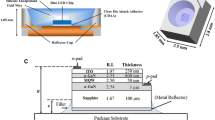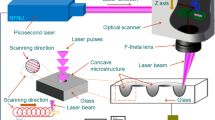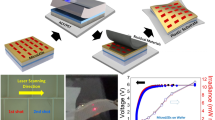Abstract
Generally, a backlight unit (BLU) is considered for the light module of a thin film transistor (TFT) LCD. A typical BLU is comprised of a light guide plate (LGP) and some optical sheets, such as two diffusion sheets, two prism sheets and a reflection sheet. To make the traditional BLU thinner and brighter, we develop an integrated LED-backlight plate (BLP) on microstructures-based, which combine several functions of optical sheets to save the space and fabrication process. The microstructures and the reflective thin film are constructed on the BLP by using micromachining and hot-embossing techniques in the research. From the results of luminous measurements, the luminous uniformity of 86.1% of our fabricated BLP has achieved a demand of a general panel. In future, the micromachining BLP could make the LED-backlight thinner, brighter and lighter for mobile phone applications.
Similar content being viewed by others
Explore related subjects
Discover the latest articles, news and stories from top researchers in related subjects.Avoid common mistakes on your manuscript.
1 Introduction
Liquid crystal display (LCD), which presents high uniform luminance, low weight, and low electric power consumption, has been widely used in the display panel of notebook, LCD-TV, laptop computer, and many portable information devices, such as cellular phones and personal digital assistants. The backlight unit (BLU) is composed of the light sources [as a cold cathode fluorescent lamp (CCFL)], a light guide plate (LGP), two diffusion sheets, two prism sheets and a reflection sheet (Fig. 1). Each optical sheet has different function in BLU. For instant, the reflection sheet under the LGP can diminish the optical loss to increase the luminance. A conventional LGP is not designed to control the luminous angle; therefore, it has poor luminance and luminous uniformity. In order to improve the uniformity of the BLU, some optical sheets including the diffusion sheet, the prism sheet and the reflection sheet are combined into the conventional LGP to make the light emit in a direction perpendicular toward the BLU top and to enhance luminous uniformity. For the market of small size panel increasing, it is desirable to make the BLU to be thinner, brighter and lighter in many researches (Akihiro and Yasuhior 2000; Serge and Denis 2000; Takamitsu et al. 2003). There are also many patents, which have been proposed for small size LCD backlight panel (Kenmochi 1992; Ciupke et al. 1996). An integrated process of silicon anisotropic etching and hot-embossing techniques are applied to fabricate the pyramid arrays for brightness enhancement film (BEF) application of BLU (Lin et al. 1998). An integrated polarized lightguide as an LC backlight is designed and fabricated (Chien and Shieh 2004). A novel LED BLU implementing a LGP with 2-D array of grating micro-dots is proposed (Park et al. 2007). The polymethylmethacrylate (PMMA) microprisms are constructed on the integrated LGP, which can get enough uniformity of intensity (Feng et al. 2005). A new LGP with the double-sided microstructures is fabricated by using Microelectromechanical Systems (MEMS) technique for BLU application (Chien and Chen 2006).
In comparison to previous researches and patents, we develop a PMMA integrated LED-BLP (backlight plate) with the double-sided microstructures including the microprism and the micropyramid and an aluminum reflective thin film. The incident light is guided to the BLP top by the bottom microprsim. The top micropyramid could make the light in a direction perpendicular toward the front of BLP and could enhance the luminance. The aluminum reflective thin film on the microprism bottom diminishes the refractive angle and light traveling distance to avoid the light loss. The integrated LED-BLP is designed to save the space and the fabrication cost of BLU. The novel BLU could be simplified as only one integrated BLP and only one white LED light source. The size of 1.8 square inches of BLP is designed and could be applied in mobile phone panel.
2 Design concept
A typical edge-light BLU is consisted of a transparent PMMA light guiding plate (LGP) with printed reflective spots, some optics-controlling components and the CCFL. A traditional LGP is usually not designed to control the luminous angle and it is difficult to emit light in a direction perpendicular to the top surface of the LGP. The light is guided in directions diverging light sources (Fig. 2a). It is necessary to adopt diffusion sheet and prism sheet, which are combined into the traditional LGP to convert the light in normal direction of BLU top (Fig. 2b). In order to eliminate these optical components, it is necessary to design an integrated LED-BLP without any optical sheets to enhance the luminance. To describe the luminance distribution, polar coordinates will be utilized in our research (Feng et al. 2005) (Fig. 3). The angle θ is varied from 0° to 360°, and the angle α is varied from between 0° to 90° (along to the +y direction), or 0° to −90° (along to the −y direction). A reflection sheet is placed at the bottom of a microstructure LGP and guides the back leakage light into the LGP in BLU (Fig. 4a). In order to improve the uniformity of BLU; therefore, we designed an integrated BLP with the double-sided microstructures and the reflective thin film on bottom surface of microstructure (Fig. 4b).
In this research, three different kinds of the microstructures are designed in our BLP. To design the microprisms, the variable widths of the microprisms are designed from 60 to 250 µm and the minimum depth of 42.4 µm to the maximum depth of 176.8 µm with the gap of 20 µm gap between two microprisms (Fig. 5a). To design the micropyramids, the area of the each micropyramid is design to be 100 µm × 100 µm with a gap of 20 µm between two micropyramids (Fig. 5b). To design the concentric circle microprisms, the width of 50 µm and the length of 100 µm at the bottom prisms are designed with the depth of 35.3 µm and a gap with 150 µm between two microprisms (Fig. 5c).
3 Manufacturing method
Anisotropic etching process is utilized to fabricate the mold of the microstructure. We then chose the PMMA material with the microstructure mold to form the microprism LGP through hot-embossing process. The microprism mold and the micropyramid mold are applied to make the double-sided PMMA optical component. Finally, the reflective thin film of alumina is deposited on the bottom of the optical component by sputter to complete the integrated BLP.
3.1 Fabrication of silicon mold
For fabrication process of the microstructure mold, the polyimide photoresist is spun on the N-type (100)-oriented silicon wafer with silica nitride (Si3N4) film. After lithography process, the microstructure patterns are defined. The silica nitride layer inside the patterns should be removed through RIE process, and then the photoresist is stripped. After that, the microstructures are formed by anisotropic etching on the silicon substrate. Finally, the microstructure mold is completed after dry etches the resisted silica nitride. Figure 6 shows the whole fabrication process of microstructure mold. Three kinds of the silicon molds including the microprism mold, the micropyrmid mold and the concentric circle mold are completed (Figs. 7, 8, 9).
3.2 Fabrication of integrated BLP
PMMA material is chosen to fabricate the optical component by using hot-embossing process. PMMA is deformed through the silicon mold with the molding temperature up to 120°C and the clamping force of 410 kgw. To hold the clamping force during cooling could avoid the shrinkage of the microstructure. The microprism LGP and the concentric circle LGP are completed (Figs. 11, 12). The operation parameter of the hot-embossing process is shown in Table 1. To fabricate the integrated BLP, the microprism mold, the micropyramid mold and the PMMA material are used to fabricate the double-sided optical components of microstructures by hot-embossing technique (Fig. 10) and to deposit the Al reflective thin film on the bottom side by using sputtering technology (Fig. 13a, b).
4 Measurement and comparison luminance
These three kinds of optical components are placed on the optical plate, and then the luminance meter is utilized to measure the luminance of these components with one white LED light source inside the black box (Fig. 14 a, b). The nine test positions are chosen to measure the luminous distribution, as shown in Fig. 15 (following the American national standards institute). Equation (1) is presented to calculate the uniformity of luminance, and can be expressed as:
where L max is the maximum luminance, L min is the minimum luminance and the U is the uniformity of luminance.
Figure 16a shows the 74.9% luminous uniformity of the microprism LGP. After measuring the concentric circle LGP, the luminous uniformity is given as 76.3% (Fig. 16b). Figure 16c shows the measurement result of the integrated BLP, and the luminous uniformity is 86.1%. Figure 17 shows the comparison of luminous uniformity of microprism LGP, concentric circle LGP and the integrated BLP. According to the data, the luminous uniformity of the integrated BLP has achieved the demand of a general optical sheet. Thus, the integrated BLP combines several functions of optical components and it is demonstrated using micromachining and hot-embossing technologies successfully in this research.
5 Conclusion
Micromachining and hot-embossing technologies are applied to fabricate the PMMA integrated BLP, which resulted in a significant savings of space and processing cost of the BLU. From the measuring result of luminance, the 86.1% luminous uniformity of the integrated BLP is better than the other optical components in the research. The integrated BLP has achieved the standard of the general BLU. We combine three functions of optical components to make the integrated LED-BLP using a simple and cheap technique. Our fabricated integrated LED-BLP is shown to be effective in making the displays thinner, lighter and brighter for thin film transistor (TFT) LCD applications.
References
Akihiro T, Yasuhior K (2000) Highly-efficient backlight for liquid crystal display having no optical films. Macromol Symp 154:73–82. doi:10.1002/1521-3900(200004)154:1<73::AID-MASY73>3.0.CO;2-Z
Chien CH, Chen ZP (2006) Fabrication of light guiding plate of double-side hot-embossing. Mater Sci Forum 505–507:211–216
Chien KW, Shieh HPD (2004) Design and fabrication of an integrated polarized light guide for liquid-crystal-display illumination. Appl Opt 43(9):1830–1834. doi:10.1364/AO.43.001830
Ciupke WW, Redmond WF, DuNah RE (1996) Flat light display lighting system. US Patent 5,485,354
Feng D, Yan YB, Yang XP, Jin GF, Fan SS (2005) Novel light-guide plates for liquid crystal display backlight. J Opt Appl A 7:111–117. doi:10.1088/1464-4258/7/3/003
Kenmochi Y (1992) Uniform illumination plate. US Patent 5,128,842
Lin LW, Cheng YT, Chiu CJ (1998) Comparative study of hot embossed micro structures fabricated by laboratory and commercial environments. Microsyst Technol 4:113–116. doi:10.1007/s005420050109
Park SR, Kwon OJ, Shin D, Song SH, Lee HS, Choi HY (2007) Grating micro-dot patterned light guide plates for LED backlights. Opt Express 15(6):2888–2899. doi:10.1364/OE.15.002888
Serge H, Denis V (2000) New micro-prism geometry in light guiding plate for illumination devices. Proc SPIE 3954:28–33. doi:10.1117/12.383376
Takamitsu O, Aklhiro T, Yasuhiro K, Masahiro H, Hiromasa S (2003) Appl Phys Lett 83(13):2515–2517. doi:10.1063/1.1613051
Acknowledgments
The authors gratefully acknowledge the financial support provided to this study by the National Science Council, R.O.C, under Grant No.NSC96-2221-E-036-009.
Author information
Authors and Affiliations
Corresponding author
Rights and permissions
About this article
Cite this article
Chien, CH., Chen, ZP. The study of integrated LED-backlight plate fabricated by micromachining technique. Microsyst Technol 15, 383–389 (2009). https://doi.org/10.1007/s00542-008-0723-z
Received:
Accepted:
Published:
Issue Date:
DOI: https://doi.org/10.1007/s00542-008-0723-z





















